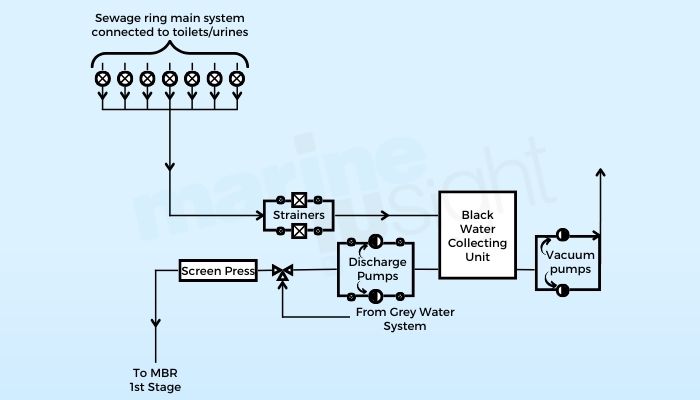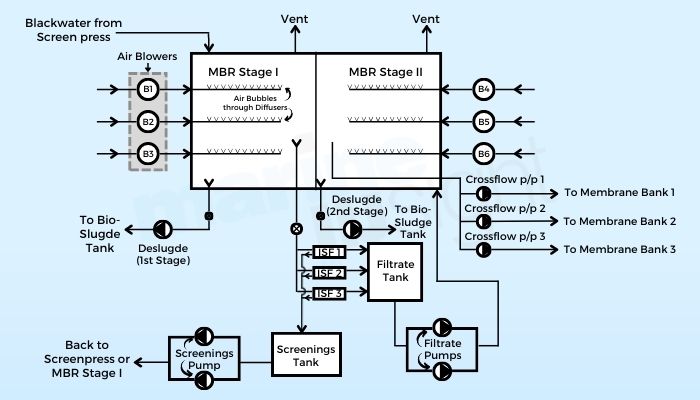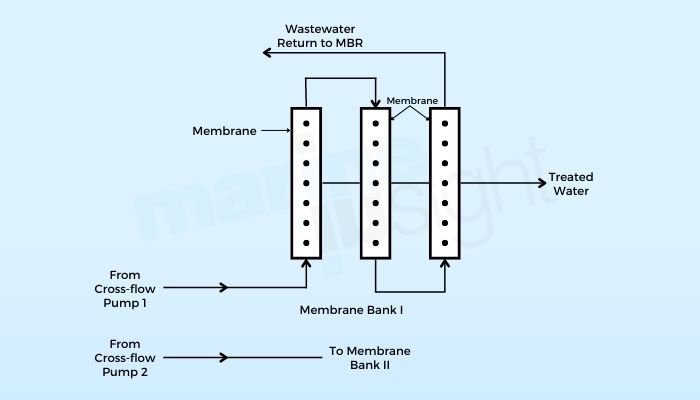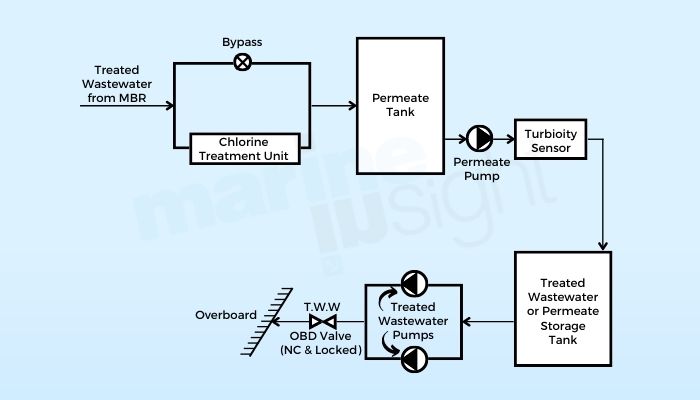Blackwater Treatment Onboard Cruise Ships Explained
Cruise ships house thousands of passengers and crew, which leads to enormous wastewater generation of up to 1000 cubic metres per day. Hence, Wastewater management has become a critical aspect of everyday operations.
A cruise ship needs to be self-reliant in this aspect, as it stays away from land for a considerable period of time.
Wastewater onboard cruise ships are categorised into two types, namely, greywater & blackwater.
Greywater comes from bathrooms, showers and washbasins. The water from galleys, meat rooms, fish rooms and laundries is also greywater. However, such water is called galley & laundry grey water for ease of differentiation.

Blackwater is the dirty water from toilets and urinals, including flushed water. Since it consists of human waste, which is infectious & an environmental hazard, it needs special handling & treatment processes for its storage onboard or its discharge overboard outside ecological limits.
Therefore, our focus in this article will be on blackwater management, treatment and disposal.
Related reading:
- Sewage Treatment Plant on Ships Explained
- 4 Important Terms Related to Sewage Treatment Plant on Ships
Blackwater Collection & Segregation/Pre-treatment
Blackwater is collected in blackwater collecting units via a ring-main system. The ring-main system is divided by various decks or zones onboard and connected to different blackwater collecting units.
There can be multiple numbers of collecting units (4-10 units) depending upon the size of the ship. They are usually installed in technical spaces throughout the ship, where technical staff can monitor and maintain them.
The blackwater is collected in the collecting tanks by gravity or vacuum. In the case of a vacuum system, the vacuum is generated in the collecting tank & its suction line using attached vacuum pumps which operate per the vacuum level through sensors.
The blackwater goes to the collecting units through coarse strainers, which must be cleaned daily or as per demand. These strainers remove any large-sized solids that may go to the collecting tanks, clog pipework or the discharge pumps.

The blackwater collecting units have attached discharge pumps that are normally set to work on a timer but can also be set to work on the level. The pumps are operated by float switches and operate from time to time to lower the level of the blackwater collecting units. These pumps are sewage discharge pumps and transfer the blackwater from the collecting units to screen presses.
The screen presses further separate the solids, such as toilet paper, plastics, grit, fibres, rags etc., from the blackwater, thus ensuring that only the liquid passes through to the next stage, which is the treatment stage.
This is done by first separating the larger-sized solids by a mesh called a screen and, after that, removing the fine suspended solid impurities by a large screw shaft operated by a motor, which grinds and separates out the finer solids.
The screened or filtered blackwater passes through to the next stage, the treatment stage, whereas the separated solids from the screen press are collected in a separate tank, usually known as a Bio-sludge tank.
Accommodated greywater can also be fed to the MBRs along with blackwater. This process is automatically controlled as per demand, with the help of a 3-way valve at the inlet to the screen presses. At times of low blackwater generation, which is usually at night when most people are asleep, the 3-way valve supplies greywater to the MBR system to maintain the levels of the stages.
In the above case, the accommodation greywater is stored in separate double-bottom tanks. MBR greywater pumps are provided, which operate automatically as per the greywater demand from the MBR and the level of greywater in the DB tanks.
Treatment Process
The screened/filtered blackwater goes to the sewage treatment plant known as MBR. MBR stands for Membrane Bio-Reactor. As the name suggests, it treats sewage or blackwater through biological processes and membrane filtration.
The MBR has two stages. The blackwater from the screen presses comes to the 1st stage, where aerobic bacteria treat it. A constant air supply generates aerobic bacteria through blowers and diffusers, which create air bubbles for evenly distributing the air throughout the biomass. Excess air, water vapour & gases are vented from both stages by attached vent lines to the atmosphere.
The aerobic bacteria act on the sewage, thus breaking it down & separating the sludge from the sewage water. The treated water now passes through to the 2nd stage of the MBR, through the ISFs, which stands for Inter-Stage Filters.

The ISFs help to remove any finer particles or impurities that may have been generated in the first stage or carried over from the pre-treatment stage. The filtrate from the ISF is collected in an attached filtrate tank, from where it is pumped to the 2nd stage of the MBR by filtrate pumps, whereas the separated screenings (solids) collected in the screenings tank and are either pumped back to the screen press or the 1st stage by the screening pumps. Both the filtrate & screenings pump has one operational pump & one standby pump.
The condition of the ISFs must be regularly checked, and the filters cleaned if required. The filtrate to screenings ratio is a parameter that indicates the health of the ISFs. Usually, the ratio should be between 1 and 5. Readings well outside this range will necessitate checks and/or adjustments.
Like in the 1st stage, further aerobic action also takes place in the 2nd stage. This is to ensure that sludge separation takes place as much as possible so that only liquid passes through to the membrane-filtration stage, thus reducing the possibility of membrane clogging and/or breakage, which can result in downtime and increased maintenance.
The separated sludge from both the 1st stage & 2nd stage must be removed daily to prevent the accidental carryover of the sludge along with the liquid to the membrane. There are separate sludge pumps and tanks which are provided for that purpose. Chemical dosing is also done in both stages for sewage sludge conditioning.
The liquid (wastewater) under treatment is pumped from the bioreactor’s 2nd stage to the membranes by the centrifugal crossflow pumps. The membranes are usually arranged in multiple (usually 3 to 4) parallel banks. Each bank has several membranes in series & its crossflow pump. The individual banks can be isolated for cleaning or maintenance without disturbing the process.

Each membrane is tubular, with 8 mm nominal bore tubes mounted onto 200 mm nominal diameter fibre-reinforced casings. The membranes are rated in the ultra-filtration range, with a nominal pore size of 40 nanometres.
There are several billions of such microscopic pores on the surface of the membrane fibre, which while forming a barrier to microbial impurities such as bacteria, viruses and protozoa, allow pure water molecules to pass through, thus affecting treatment. The untreated wastewater recirculates back to the bioreactor 2nd stage.
The membrane banks, which foul due to accumulation of impurities, must be backflushed or flushed with clean freshwater once each day and chemically cleaned once a week for continued operational reliability and to avoid breakdown and damage to membranes. Membrane replacement can be a costly and time-taking affair.
The membrane-filtered liquid, known as permeate or treated wastewater, may be treated with chlorine for further disinfection before being pumped to permeate or treated wastewater storage tanks through a Turbidity sensor, which stops the permeate pump in case of high turbidity.
The stored permeate is pumped overboard, if & when outside of environmental limits, by treated wastewater pumps. Chlorine treatment (disinfection), in the case of MBRs, is not usually necessary if the bio-reactor & membranes are performing well.
Weekly tests must be performed for Biological/Chemical Oxygen Demand, smell, colour and E-Coli by taking samples from both stages of the bio-reactors permeate to ascertain the performance of the MBR plant.
While accommodation greywater can be supplied to the MBR, it is not advisable to use galley & laundry greywater, as the presence of detergents and/or oils can potentially be detrimental to the aerobic bacteria, thereby affecting biomass generation and function. For this reason, galley and laundry greywater also have their own separate storage tanks.
Blackwater management is a complex process that demands a comprehensive understanding of the system, strict attention to parameters, adherence to proper & timely maintenance procedures and accurate troubleshooting for continued efficiency and operational continuity.
The system’s complexity can also be a factor in the size of the ship. Bigger ships will put a considerable load in terms of operations & routines. Although designed to operate automatically and without manual assistance, systems are always prone to failure. It is advisable to follow manufacturer guidelines, manuals, maintenance schedules & regular testing to ascertain the plant’s health.
You might also like to read-
- The World Largest Cruise Line: Carnival Cruise Ships
- The Vista Class Queen Victoria Cruise Ship
- The Incredible MSC Fantasia Cruise Ship
- What are Polar Cruise Ships?
Disclaimer :
The information contained in this website is for general information purposes only. While we endeavour to keep the information up to date and correct, we make no representations or warranties of any kind, express or implied, about the completeness, accuracy, reliability, suitability or availability with respect to the website or the information, products, services, or related graphics contained on the website for any purpose. Any reliance you place on such information is therefore strictly at your own risk.
In no event will we be liable for any loss or damage including without limitation, indirect or consequential loss or damage, or any loss or damage whatsoever arising from loss of data or profits arising out of, or in connection with, the use of this website.
Do you have info to share with us ? Suggest a correction
Disclaimer :
The information contained in this website is for general information purposes only. While we endeavour to keep the information up to date and correct, we make no representations or warranties of any kind, express or implied, about the completeness, accuracy, reliability, suitability or availability with respect to the website or the information, products, services, or related graphics contained on the website for any purpose. Any reliance you place on such information is therefore strictly at your own risk.
In no event will we be liable for any loss or damage including without limitation, indirect or consequential loss or damage, or any loss or damage whatsoever arising from loss of data or profits arising out of, or in connection with, the use of this website.
Latest Marine Technology Articles You Would Like:
- 10 Harmful Effects Of Impure Air On Ship’s Machinery
- 10 Important Things to Check While Starting Fuel Oil Purifier on Ships
- 10 Noteworthy LNG-Powered Vessels
- 10 Points for Efficient Turbocharger Operation On Ships
- 10 Practical Tips to Handle Engine Room Pumps
- 10 Precautions to Take Before Operating Controllable Pitch Propeller (CPP) on Ships
Subscribe To Our Newsletters
By subscribing, you agree to our Privacy Policy and may receive occasional deal communications; you can unsubscribe anytime.















